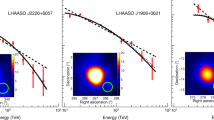Abstract
THE prospects for gamma-ray-line astronomy associated with the anticipated occurrence of radioactivity in interstellar space have already been outlined1–4. Each successive clarification of these possibilities has resulted from major clarifications in the theory of nucleosynthesis, and in this communication I wish to report another step. The supposition that the elements are coproduced in exploding stars has been greatly strengthened by quantitative success5 in the past few years. A new development within that general picture now suggests that detectable amounts of 60Fe exist in nearby explosive remnants. 60Fe has a half-life τ1/2 = 3 × 105 yr, and the subsequent decay of its 60Co daughter is accompanied by a two-gamma-ray cascade with energies Eγ=1.17 MeV and 1.33 MeV (ref. 6). This pair of equal-intensity lines is the signature that can identify 60Fe in interstellar space. The other important feature is, of course, its half-life, which is long enough to allow the radioactivity to persist long after (in terms of recorded history) the explosive event.
This is a preview of subscription content, access via your institution
Access options
Similar content being viewed by others
References
Clayton, D. D., and Craddock, W. L., Astrophys. J., 142, 189 (1965).
Clayton, D. D., Colgate, S. A., and Fishman, G. J., Astrophys. J., 155, 75 (1969).
Clayton, D. D., and Fowler, W. A., Comments Astrophys. and Space Sci., 1, 147 (1969).
Clayton, D. D., and Silk, J., Astrophys. J., 158, L43 (1969).
Arnett, W. D., and Clayton, D. D., Nature, 227, 780 (1970).
Lederer, C. M., Hollander, J. M., and Perlman, I., Table of Isotopes (Wiley, New York, 1967).
Katgert, P., and Oort, J. H., Bull. Astron. Netherlands, 19, 239 (1967).
Cameron, A. G. W., in The Origin and Distribution of the Elements (edit. by Ahrens, L. H.) (Gordon and Breach, New York, 1968).
Howard, W. M., Arnett, W. D., Clayton, D. D., and Woosley, S. E., Phys. Rev. Lett. (in the press).
Howard, W. M., Arnett, W. D., Clayton, D. D., and Woosley, S. E., Astrophys. J. (in the press).
Allen, B. J., Gibbons, J. H., and Macklin, R. L., in Advances in Nuclear Physics (edit. by Baranger, N., and Vogt, E.), 4 (Plenum, New York, 1971).
Peters, J. G., Fowler, W. A., and Clayton, D. D., Astrophys. J. (in the press).
Arnett, W. D., Truran, J. W., and Woosley, S. E., Astrophys. J., 165, 87 (1971).
Author information
Authors and Affiliations
Rights and permissions
About this article
Cite this article
CLAYTON, D. New Prospect for Gamma-Ray-Line Astronomy. Nature 234, 291–292 (1971). https://doi.org/10.1038/234291a0
Received:
Issue Date:
DOI: https://doi.org/10.1038/234291a0
This article is cited by
-
Positronium Origin of 476 keV Galactic Feature
Nature Physical Science (1973)
Comments
By submitting a comment you agree to abide by our Terms and Community Guidelines. If you find something abusive or that does not comply with our terms or guidelines please flag it as inappropriate.



